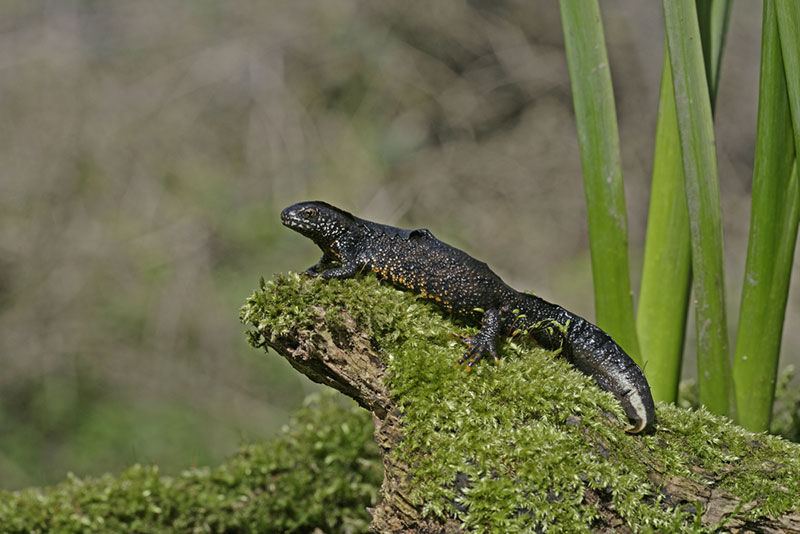
Overview/Process
eDNA analysis begins with the collection of water, soil, or sediment samples from an environment where they want to study the presence of specific organisms. In a lab, the genetic material is extracted by cutting out and isolating segments of DNA. The enzymes used to cut the DNA fragments can be specifically tailored to certain regions along the strand according to the organism or research question of interest. A polymerase chain reaction (PCR) may be used to selectively amplify (make extra copies of) specific genetic markers or regions. Finally, the sample DNA is compared to reference databases (such as BOLD) to identify the presence of specific species or organisms.

Next Generation Sequencing (NGS) is the game-changing methodological refinement that is largely responsible for lowering the cost of the process and extending its utility. The original Sanger DNA sequencing method from 1977 sequences only a single DNA fragment at a time. Therefore, in order to use it, researchers were conservative and needed to know which fragment they had from which organism and compare it to its specific counterpart in another population or species. In contrast, NGS offers enormous sequencing volume, so that millions of fragments can be sequenced simultaneously per run. It has also allowed DNA samples from more diverse sources; for example, lowering the bar on how clean and pure the samples need to be and allowing researchers to start sequencing old or even ancient DNA from museum specimens. The sheer volumes possible through NGS have allowed researchers to throw large batches of unknown DNA together, chop them with generalist primers, and use big data techniques to sort through the results to estimate numbers of species or identify specific targets, a combination of steps known as “metabarcoding.”
The new eDNA techniques have too many applications to describe, but the papers listed in the Resources section of Leaf Litter provide substantial reviews. Two applications of special importance are detecting critically important species and examining soil communities.
Detecting Invasive and Endangered Species
eDNA is not yet widely approved as a survey or detection technique in situations where it really matters, but there are a few telling exceptions. In the UK, the rare and secretive great crested newt (Triturus cristatus) is nationally protected, and developers must show that they have surveyed for them on potential sites and found none. eDNA-based surveys of great crested newts are an approved methodology for ecological impact assessments because they are recognized to have a greatly superior precision relative to the cost of investigation. We should note that eDNA analysis, generally, is more likely to show false positives than false negatives, which is an important standard for conservation of critically endangered species.

Great crested newt (Triturus cristatus)
On the other side of the spectrum, eDNA is used extensively to detect malevolent hitchhikers in boat ballast water and other known culprits in spreading invasive species. eDNA is regularly used, for example, to sample bighead carp (Hypophthalmichthys nobilis) and silver carp (Hypophthalmichthys molitrix), in efforts to forestall their spread in the US.
Soil eDNA
Metabarcoding that combines NGS with universal primers for common genetic regions is perhaps the most discussed application of eDNA analysis, wherein we can assess species richness in mixed, bulk samples of taxa. Metabarcoding has opened the door to groups that are difficult to survey, such as microbes and a variety of invertebrates, which has led to a body of work that is revolutionizing our understanding of soil ecology.
By analyzing eDNA in soil, researchers can determine which plant species, fungi, bacteria, and other organisms are present in a given area. This information can be used to assess biodiversity, track invasive species, monitor ecosystem health, and study soil microbial communities. Soils, the foundation of ecological restoration efforts, could be a critically important part of biodiversity monitoring to understand the efficacy of restoration techniques or high-performance landscape design. eDNA offers a new, solid metric to understand the ecological devastation of removing topsoil in scraped earth developments and can be easily integrated into landscape performance standards such as the Living Building Challenge’s Ecology of Place Petal, SITES, or other certifications that explicitly consider biodiversity.
DNA signals in soil can even provide information about the vascular plant community. About 60% of the vascular plants and bryophytes recorded across all vegetation surveys were detected by soil eDNA in an old-growth boreal forest in southern Norway.
Looking Ahead
eDNA holds enormous promise as a means to determine and analyze the presence of species at a site. Although powerful, there are limitations one must consider for monitoring. DNA degrades in the environment, leaving only small segments of genetic material, a problem that is especially acute in the warm, tropical regions that are home to so much global biodiversity. Therefore, just because a sample does not indicate the presence of a specific species of interest, that does not conclusively mean that that species is not present. Moreover, a positive indication of species presence might be due to DNA hitching a ride from another site on the feet of a bird. These misleading signals simply need to be acknowledged. Despite the possibility of erroneous presence or absence, eDNA is emerging as a cost-effective tool for characterizing the community of flora, fauna, archaea, and fungi of a specific site. As the technology advances, we hope it will be a tool that raises the bar for ecological restoration and high-performance landscape design.

